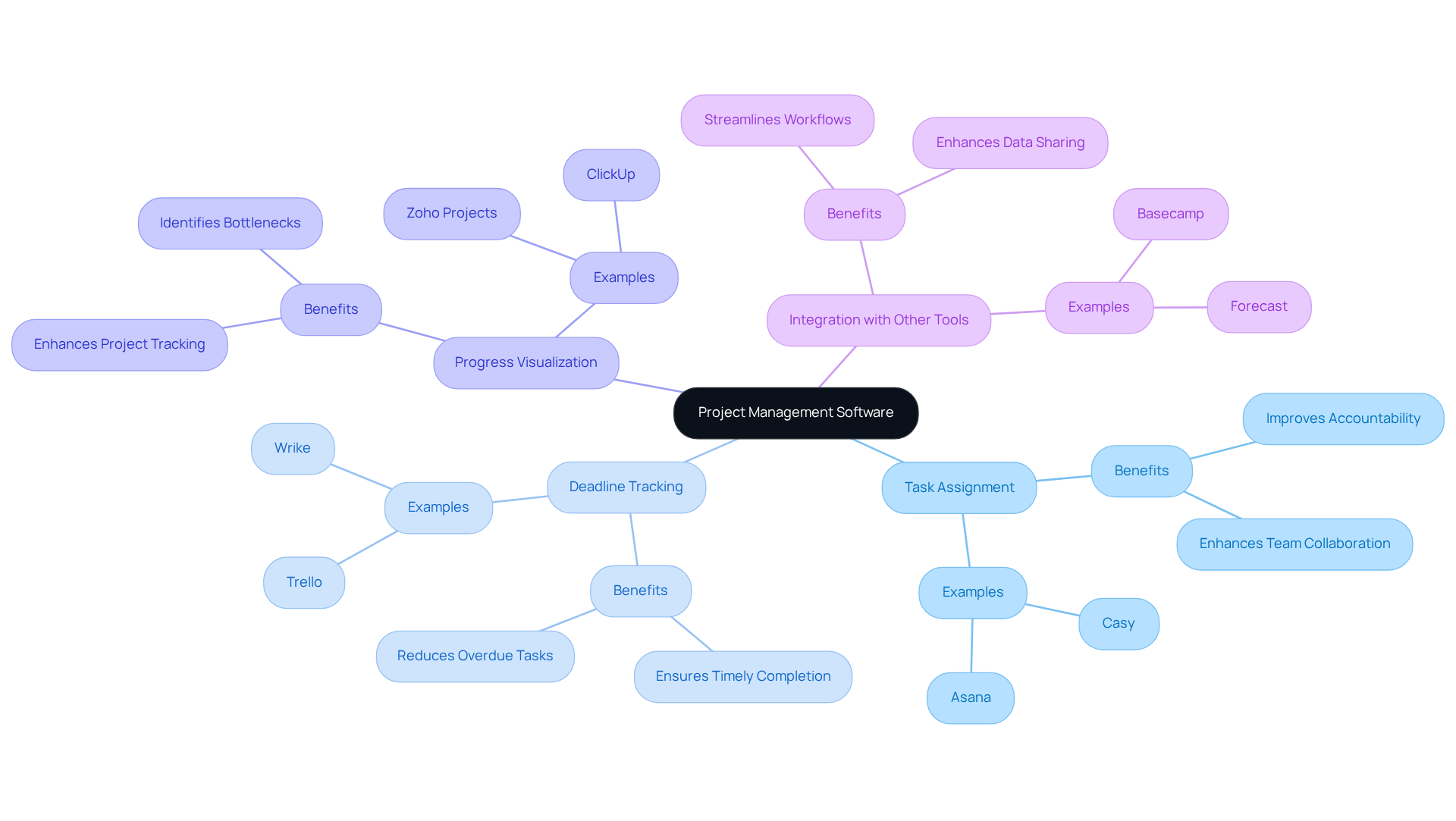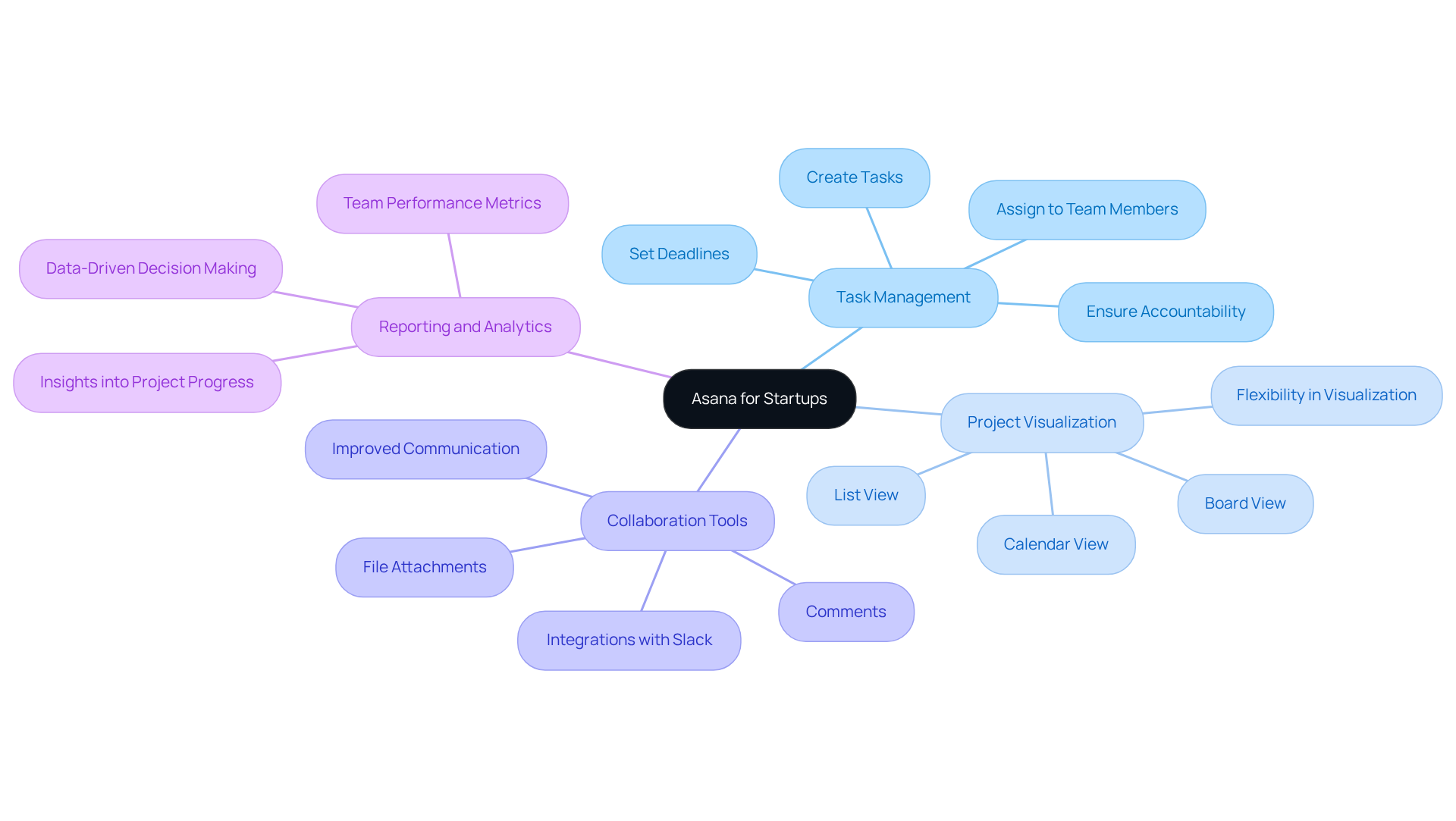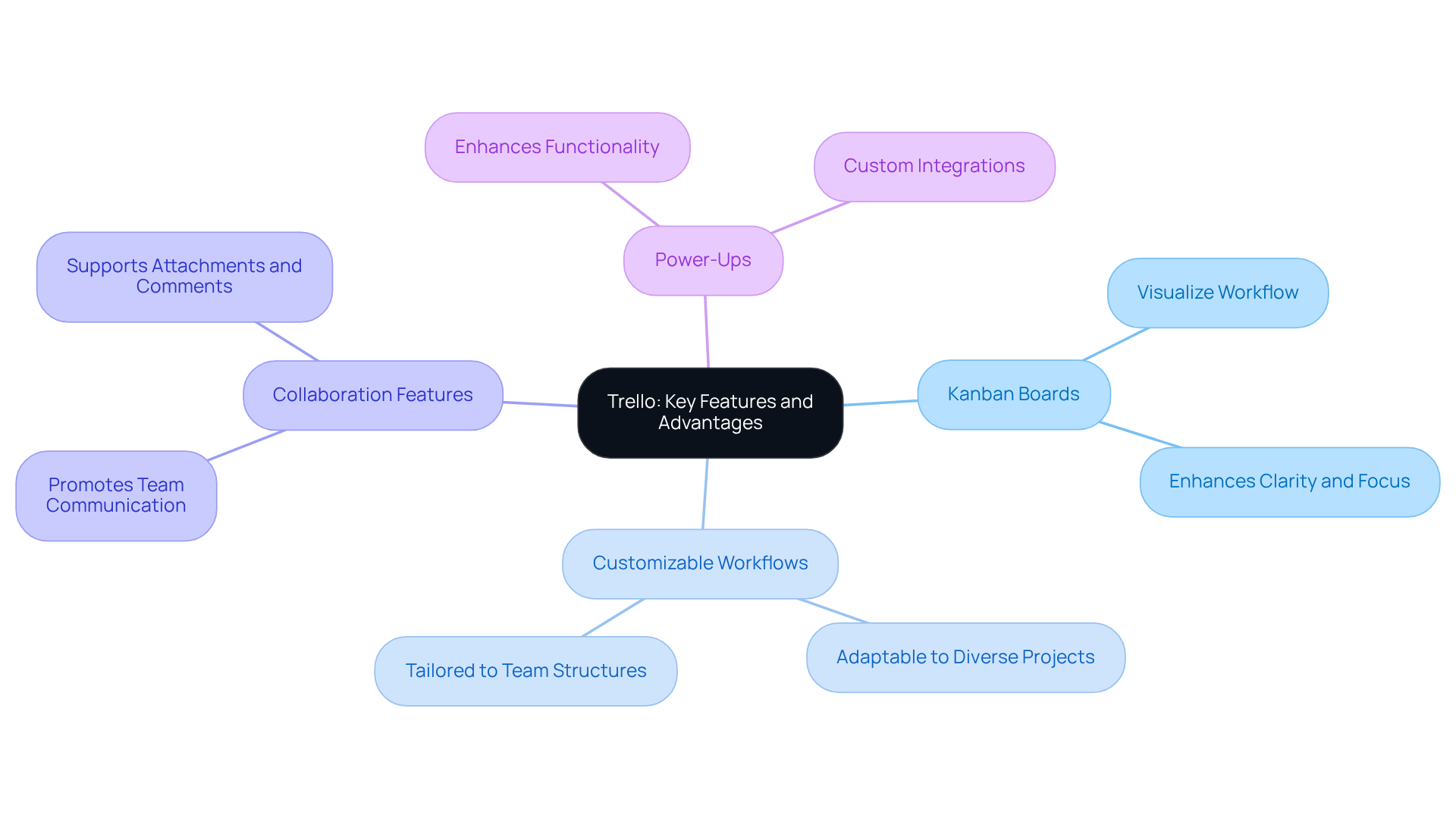Overview
This article provides a comprehensive comparison of Asana and Trello, two prominent project management software options tailored for startups. It highlights their unique features and advantages, establishing a clear understanding of their capabilities.
- Asana stands out for its robust task management and reporting functionalities, making it particularly well-suited for complex projects.
- In contrast, Trello is celebrated for its user-friendly, visual interface that simplifies task organization.
This distinction allows each platform to cater effectively to the diverse needs of startups, empowering founders to choose the right tool for their specific challenges.
Introduction
In the dynamic landscape of startups, effective project management is not merely beneficial; it is essential for survival and growth. The right project management software can streamline operations, enhance team collaboration, and ultimately drive success.
This article presents a comparative analysis of two leading tools—Asana and Trello—highlighting their unique features and benefits tailored specifically for startups. As businesses navigate the complexities of project execution, a critical question arises:
- Which tool truly stands out in fostering productivity and efficiency?
- How can startups make the best choice for their specific needs?
Understanding Project Management Software
Management software is essential for planning, executing, and monitoring initiatives, particularly for startups facing tight deadlines and limited resources. These tools streamline task organization, progress tracking, and team collaboration, significantly reducing operational overhead. By automating routine processes and providing a centralized communication platform, management software enhances efficiency and productivity. Key features include:
- Task assignment
- Deadline tracking
- Progress visualization
- Integration with other tools
Each feature is vital for startups striving to optimize their management processes.
In the fast-paced environment of startups, where agility is paramount, conducting a project management software comparison can profoundly impact the achievement of business goals. For instance, Casy connects with popular chat platforms like Slack and Telegram to automate task creation and updates, allowing teams to focus on their core activities. Trello and another tool also emerge as preferred options, each catering to different management styles and team needs. Understanding their unique offerings is crucial for startups to conduct a project management software comparison that aligns best with their operational requirements, ultimately boosting efficiency and productivity in their efforts.

Exploring Asana: Features and Benefits for Startups
This robust management tool offers a project management software comparison specifically designed to meet the needs of startups, featuring a diverse array of functionalities that enhance operational efficiency. Key functionalities include:
- Task Management: Asana empowers users to create tasks, assign them to team members, and set deadlines, ensuring accountability and clarity in project execution.
- Project Visualization: With options for list, board, and calendar views, the platform offers flexibility in how teams visualize their work, catering to varied preferences and workflows.
- Collaboration Tools: This platform enhances communication through comments, file attachments, and integrations with tools like Slack, significantly improving group collaboration.
- Reporting and Analytics: Startups can leverage the reporting features of this tool to gain insights into project progress and team performance, enabling data-driven decision-making.
Utilizing a project management software comparison enables startups to achieve better task organization, enhance team collaboration, and scale effectively as the team grows. Notably, the platform offers the 'Program for Startups,' which provides up to 80% off for qualifying early-stage companies, making it a budget-friendly solution. Its user-friendly interface and comprehensive features position it as a preferred choice for startups aiming to streamline their management processes. Furthermore, groups utilizing management software like Asana report a 52% improvement in communication, underscoring its efficiency in fostering collaboration and productivity. However, it is essential to recognize that there may be a learning curve for teams unfamiliar with management tools. Asana's strong market presence is evidenced by a remarkable revenue increase of 72% from 2022 to 2024, reinforcing its reliability as a management tool.

Examining Trello: Key Features and Advantages
This tool is widely recognized for its user-friendly, card-based interface that streamlines task management. Its key features include:
- Kanban Boards: The cornerstone of Trello, these boards allow teams to visualize their workflow by moving cards (tasks) through various stages of completion. This enhances clarity and focus, essential for effective project execution.
- Customizable Workflows: Users can tailor boards to fit their specific processes, making the platform adaptable to diverse project types and team structures. This adaptability is particularly beneficial for startups navigating rapid changes.
- Collaboration Features: This platform fosters teamwork through comments, attachments, and integrations with other tools, promoting effective communication and cooperation among team members.
- Power-Ups: This feature enables users to enhance the platform's functionality with various integrations, allowing teams to customize their experience based on unique needs.
The advantages of utilizing this project management software comparison tool for startups are substantial. Its simplicity and ease of use make it an ideal choice for teams seeking a direct management solution. The visually appealing interface not only aids in task organization but also enhances user engagement. Moreover, its flexibility allows startups to adapt the tool as their needs evolve, ensuring efficient project management without the burden of unnecessary complexity. Statistics reveal that the platform's user-friendly design has positioned it as a preferred choice among startups, with many praising its capacity to boost productivity and streamline workflows. Additionally, the platform boasts an impressive aggregated rating of 4.6 from Crozdesk users, reinforcing its credibility.
With pricing starting at $5 per user monthly for the Standard plan and $10 per user monthly for the Premium plan, this platform presents an economical option for startups. However, it is essential to consider that some users have raised concerns regarding its limitations for complex project management in the framework of project management software comparison. The platform's integration capabilities with various business applications, including Slack and Google Drive, further enhance its adaptability. Furthermore, it complies with GDPR and CCPA regulations, ensuring data privacy and security for startups managing sensitive information.

Comparative Analysis: Asana vs. Trello for Startups
When comparing Asana and Trello for startups, several critical factors come into play:
-
User Interface: Asana provides a structured approach with multiple views (list, board, calendar), whereas Trello's card-based interface offers a visual and flexible experience. User feedback indicates that Asana is appreciated for its straightforwardness and visual appeal, making it a preferred choice among smaller teams.
-
Task Management: Asana excels in task management with features like subtasks, dependencies, and advanced reporting, making it suitable for complex projects. In contrast, Trello is simpler and may better serve teams that prefer a straightforward task management approach. As Brett Day highlights, "Asana is a more powerful system with additional workflow tools, while Trello focuses entirely on kanban techniques."
-
Collaboration: Both tools support teamwork, but Asana's built-in communication features offer a more integrated experience compared to Trello's reliance on comments and attachments. The collaborative notes and messaging system in Asana enhance user experience, allowing seamless interaction within tasks.
-
Customization: Trello's adaptable boards and Power-Ups provide increased flexibility, while Asana's organized templates assist teams in maintaining uniformity across tasks. This adaptability in Asana is particularly advantageous for teams that excel in personalization.
-
Scalability: Asana is designed to grow alongside expanding teams and initiatives, offering advanced features that accommodate larger operations. Trello is also scalable but may require additional Power-Ups for more complex needs. Case studies reveal that teams utilizing Asana gain deeper insights into project progress and reduce manual work through automation, enhancing overall efficiency.
In conclusion, the choice between these two tools can be better understood through a project management software comparison that ultimately hinges on the specific needs and preferences of the startup. Teams requiring robust task organization and reporting may find Asana more advantageous, while those seeking a straightforward, visual tool might favor Trello. User preference statistics indicate that while both tools are well-regarded, Asana tends to receive higher ratings for its comprehensive feature set, whereas Trello is favored for its user-friendly design.

Conclusion
The evaluation of project management software, such as Asana and Trello, stands as a pivotal consideration for startups striving to enhance operational efficiency and streamline team collaboration. Each tool presents distinct features tailored to various management styles and team needs, making it essential for startups to select the one that aligns best with their specific requirements. By comprehensively understanding the unique capabilities of Asana and Trello, startups can make informed decisions that significantly impact their productivity and project success.
Key points of discussion include:
- Asana's robust task management and reporting features, which cater effectively to complex projects.
- Trello's user-friendly, visual interface that excels in simplicity and adaptability.
- Asana's comprehensive functionalities support larger operations and provide deeper insights.
- Trello's flexible boards and Power-Ups offer a customizable experience for diverse teams.
Ultimately, the choice between these tools will hinge on the startup's size, project complexity, and team preferences.
In today's rapidly evolving business landscape, leveraging the right project management software transcends convenience; it becomes a strategic necessity. Startups are urged to conduct thorough comparisons and reflect on their unique operational needs when choosing between Asana and Trello. By doing so, they can pave the way for enhanced collaboration, improved productivity, and greater overall success in achieving their business objectives.
Frequently Asked Questions
What is the purpose of project management software?
Project management software is essential for planning, executing, and monitoring initiatives, especially for startups with tight deadlines and limited resources. It streamlines task organization, progress tracking, and team collaboration, reducing operational overhead.
What are the key features of project management software?
Key features of project management software include task assignment, deadline tracking, progress visualization, and integration with other tools.
How does project management software enhance efficiency and productivity?
By automating routine processes and providing a centralized communication platform, project management software enhances efficiency and productivity for teams.
Why is it important for startups to compare project management software?
In the fast-paced environment of startups, where agility is crucial, comparing project management software can significantly impact the achievement of business goals by ensuring the chosen tool aligns with their operational requirements.
Can you provide an example of a project management tool and its integration capabilities?
Casy is an example of a project management tool that connects with popular chat platforms like Slack and Telegram to automate task creation and updates, allowing teams to focus on their core activities.
What are some popular project management tools mentioned?
Trello and Casy are mentioned as preferred options, each catering to different management styles and team needs.




